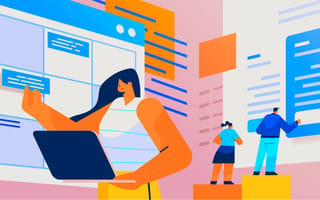Making the leap from HR director to VP of people at Vimeo in 2014 was one of Charmein Fugelsang’s biggest professional milestones. It was a huge achievement that laid the groundwork for her to take on her current role, a chief people officer job at New York-based software company nTopology.
She credits Vimeo mentors like Lindsay Deak Friedman, Michael Weissman and Anjali Sud, who helped her develop communication skills, gave her new opportunities, and pushed her to leave her comfort zone. With their input, Fugelsang was able to draft and follow through on a career development plan that got her closer to her goals.
“Great leaders need to be very aware of their strengths and weaknesses to successfully move forward and I frequently asked for feedback to make sure I was progressing and not becoming too complacent,” she said. “But most importantly, I shared my goal with the leaders I worked with and ultimately they helped me make a dream a reality.”
What Is a Professional Development Plan?
When it comes to career goals, taking action with a professional development plan is the most effective way to make real progress. A professional development plan is a guide that outlines concrete steps employees can take to build their skills and level up their careers. Employees are the main captains of their professional progress — but as Fugelsang’s story illustrated, support from leaders every step of the way is crucial.
“Today, everyone is a leader in some capacity, and they must have access to resources to navigate these responsibilities with confidence,” said Rashim Migha, general manager of Boston-based e-learning company Skillsoft’s leadership and business portfolio. “Organizations need to create opportunities for continuous learning, where every employee can invest in themselves on an ongoing basis and constantly hone, grow and evolve their skills.”
Professional development plans help your employees reach their goals, but they also have a lot of other hidden plus-sides. Here are 5 major benefits of using professional development plans, and how helping your employees draft them will make you a better leader.
Turn Aspirations Into Actions
It takes a concrete plan to make any dream come true. That’s why professional development plans are so helpful — they work as a ladder with steps you can climb to reach your goals, Mogha said.
“Professional goals should be trackable, relevant and achievable,” said Mogha. “They should also align with each organization’s strategic business objectives and skills initiatives.”
“It’s important to have long-term goals, but it is just as important to break up those goals into a series of shorter-term goals to lay out the pathway to get there.”
A strong professional development plan makes an employee’s professional goals feel more achievable, so long as the steps toward them are clear and realistic. Ideally, the action items in your employee’s plan should include a time frame or deadline. If the goals are too vague, or lack urgency, your employees won’t be compelled to work toward them.
“It’s important to have long-term goals, but it is just as important to break up those goals into a series of shorter-term goals to lay out the pathway to get there,” said Harrison Kim, CEO of New York-based HR software company Pavestep. “This process can be called reverse planning and it has been shown to increase motivation and productivity. [It] allows employees to celebrate small wins and course-correct much faster.”
Attract and Keep Talent
Ask any HR leader what their biggest worry is right now, and odds are recruiting is one of the first things they mention. In 2021, around 60 percent of people managers listed recruiting and retention as their biggest struggle points, according to a survey from Human Resource Executive. In an industry where candidates have the upper hand, leaders need to work even harder to make a strong case for themselves. One of the ways they can do so is by honing in on professional development — in fact, around 22 percent of job seekers say this is the biggest thing they look for in an employer, according to a 2018 survey from Clutch.
“Being able to showcase your professional development programs and track record of employees’ development over time is a powerful way to attract top talent, especially if you don’t have an established brand,” said Kim.
As conventional wisdom holds, it’s better (and easier) to train your current employees than hire new ones. Supporting employee growth through professional development plans also helps with retention, since giving them ample growth opportunities within your company will keep them from looking for them elsewhere.
“If your team feels that they are growing their skills and knowledge, the likelihood that they will open or respond to outside recruiters decreases,” Fugelsand said. “Internal promotions and transfers retain historic company knowledge while showing team members how much the company values and wants to keep them.”
5 Benefits of Professional Development Plans
- Turn aspirations into action: Breaking down goals into steps makes them feel more achievable.
- Attract and retain talent: Growth opportunities are a top priority for job seekers, and will keep employees with you longer.
- Strengthen rapport: Having career conversations with managers helps employees feel more comfortable and trusted.
- Build self-awareness: Employees need to accurately assess their personal strengths and weaknesses to create an appropriate action plan.
- Create accountability: A roadmap to follow and regular check-ins keep employees on track.
Strengthen Rapport
The relationships you build with your employees are almost, if not equally, as important as the work you do. When you take an interest in their career growth and help them craft a professional development plan, you’ll get to know them better and find out what they want in life. You also show that you have their best interests at heart, said Fugelsang.
“Professional growth plans serve as a commitment from the company to invest in the team member [that] says, ‘We believe you can achieve this,” she said. “[This] strengthens trust.”
Where do you see yourself next year? Who in your field do you admire most? What skills do you want to develop this year? These are all professional development plan questions that may encourage your employees to reflect, and will help you both build a more genuine partnership. A strong employer-employee relationship doesn’t just happen overnight — so start with questions, and be patient, Kim said.
“Due to the nature of the relationship between a manager and employee, it can often be hard for employees to completely open up about their professional goals and motivations,” he said. “This takes time.”
Build Self-Awareness
A professional development plan will help you learn more about your employees, and it will also put the future into focus for them. They’ll need to assess their capabilities and struggle areas to create a roadmap that’s ambitious while still being realistically achievable. Having professional development goals can strengthen self-awareness, an asset that will help your employees well into the future.
“You need to understand what your strengths and opportunities are so you can partner with your manager to build professional goals that fill in gaps and grow your professional confidence and savviness,” Fugelsang said.
Create Accountability
Leaders should lend a helping hand, but ultimately it’s the employees that are in charge of their professional development plans. You can guide them in the right direction, but you can’t achieve their goals for them. Instead, your role is to hold them accountable to their commitments, so they can develop personal accountability.
“The most important contributors are the employee and their direct manager,” said Mogha. “They must be involved from the very beginning and aligned every step of the way on what the resulting plan looks like.”
One of the most straightforward methods of maintaining accountability with professional development is by keeping detailed documentation of goal progress. In the past, Kim said that writing detailed notes on his achievements and setbacks has helped him see his long term progress more clearly.
“If you are not clear on what you want, it is nearly impossible to achieve it,” Fugelsang said.
“I also like to have an ‘accountability partner’ — whether that’s my personal coach, manager, peer, or direct report,” he said. “I share my document with them to make sure they keep me on track.”
A strong professional development plan is more than just a to-do list — it should have a collaborative element built in so employees can receive feedback, encouragement and advice along their journey. Fugelsang suggests scheduling regular check-in meetings with your employees to touch base and hear how things are going.
“At nTopology, the people team partners with managers and their reports to create Career Progression Plans,” she said. “In the plan, we detail goals for the next six months and have regular meetings to ensure both the team members and their manager are following through and supporting one another to achieve their goals.”
Whether someone wants to jump to a C-suite role or just become better at public speaking, everyone can benefit from writing their goals out and drafting a plan to achieve them. Setting personal intentions and following a roadmap toward realizing them is the key to lasting career success, Fugelsang said.
“If you are not clear on what you want, it is nearly impossible to achieve it,” Fugelsang said.







